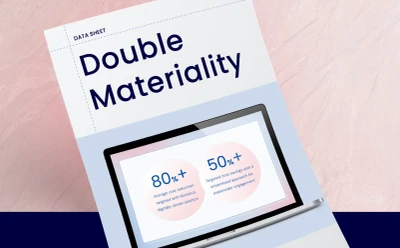
On February 26, 2025, the European Commission published the first Omnibus package—a set of proposed amendments to major EU sustainability regulations, including the Corporate Sustainability Reporting Directive (CSRD), the Corporate Sustainability Due Diligence Directive (CSDDD), and the EU Taxonomy Regulation. Framed by the European Commission as a way to cut red tape and bolster Europe’s global competitiveness, the Omnibus package was met with a wave of speculation, concern, and conflicting interpretations.
For some, it’s a necessary course correction. For others, it’s a significant retreat from the EU’s sustainability ambitions. In a political climate already charged with uncertainty, separating the signal from the noise has become increasingly difficult.
Much of the attention has centered on the CSRD—in many ways the most ambitious and technically rigorous of the EU’s sustainability regulations. Its scale, scope, and complexity have made it both a lightning rod for criticism and a bellwether for the future of ESG disclosure. If CSRD reporting is dialed back, many fear it could signal a broader retreat from mandatory sustainability reporting altogether.
Amidst the speculation, one thing remains clear: investor and market demand for reliable, comparable, and widely accessible sustainability data remains strong. That’s precisely what the CSRD was designed to deliver—establishing a new standard for investor-grade sustainability reporting across the EU. Rather than hitting pause, many organizations are staying the course, not simply because of regulatory obligations, but because high-quality sustainability data is increasingly seen as foundational to long-term business strategy. As Luke Gowland, Senior Analyst at Verdantix, recently noted in Sustainability Magazine,
“Beyond regulation, firms are encountering growing pressure from a range of stakeholders to deliver investor-grade sustainability data on a regular basis.”
We acknowledge the shockwaves the Omnibus has sent through the sustainability community, particularly for companies preparing for near-term reporting. But we also underscore an important point: regulatory changes do not alter the underlying business imperative. Sustainability risks are still business risks, and these risks need to be managed. Companies that proactively embed ESG into their strategy are more likely to remain competitive, resilient, and future-ready.
Where we stand—and what's still unfolding
The first Omnibus package is part of the European Commission’s attempt to simplify parts of the EU Green Deal’s sustainability reporting framework. It aims to ease the reporting burden and reduce compliance costs, with the potential to save billions.
Among the proposed changes, none have drawn more attention than those affecting CSRD reporting.
What’s happening with CSRD reporting?
CSRD reporting has been one of the most closely watched elements of the Omnibus proposal. The direction of travel is clear: we’re heading towards more simplification, with more relief for smaller companies. But in the interim, certain fundamentals still hold:
- The CSRD is still law. Thedirective has already been transposed into national law in over 15 EU member states, which means that companies operating in those jurisdictions are still legally required to comply. Thus, for thousands of companies—especially large EU-based and non-EU multinationals—the reporting obligations for FY2024 (with first disclosures due in 2025) remain unchanged.
- Double materiality and limited assurance remain intact. As cited in the European Commission’s Q&A on Omnibus I and II, double materiality assessments remain a core pillar of CSRD reporting. The requirement for limited assurance also stays in place; however, under the current proposal, the Commission would no longer be empowered to mandate a shift to reasonable assurance in the future. This change signals a potential ceiling on the depth of external verification, at least for now.
- Digital tagging is still on the horizon. According to Deloitte, the Omnibus proposals “do not modify the existing digital tagging or format rules introduced by the CSRD.” While the XBRL tagging mandate remains intact, companies won’t be required to do so until the regulation for digital tagging is formally adopted.
- The largest companies remain in-scope. The European Commission proposes to reduce the number of in-scope companies by approximately 80%. While estimates vary, current projections suggest that fewer than 7,000 companies would remain in scope, although some sources place that number closer to 10,000 EU-based companies. While this is a substantial narrowing of reach, it still includes the largest and most impactful companies operating in the EU market.
- Stop-the-clock has been approved. On March 26, 2025, the European Council endorsed the European Commission’s proposed “stop-the-clock” directive, which delays the implementation of both the CSRD and CSDDD. The European Parliament also approved the directive by majority vote on April 3, finalizing its adoption; this will postpone CSRD reporting for companies in Wave 2 and Wave 3 by two years. According to PwC, this provides time for the adoption of the Commission’s accompanying “content” proposal, which includes potential adjustments to the CSRD’s scope, value chain disclosures, assurance, and the ESRS.
What’s next for the Omnibus as a whole?
The Omnibus proposals are not yet law; they will first require approval by the European Parliament and the Council of the European Union. Even after adoption, each EU country must transpose the changes into national law, possibly leading to a patchwork of enforcement approaches in the interim.
As David Hageraats, Manager, ESG Services at Novisto, noted in our recent webinar: “There’s still a lot of negotiations that need to take place. The proposals will go through the regular regulatory process in the EU. And this could take months—or even years.”
For more information on the revised CSRD in-scope entities, refer to this resource by PwC. For in-depth information on the CSDDD specifically, KPMG offers a comprehensive overview.
The role of IFRS and its growing influence
Even as the details of the Omnibus continue to unfold, companies cannot afford to think of the CSRD in isolation. ESG disclosure is shaped by a myriad of standards and frameworks, and among the most influential is the IFRS Sustainability Disclosure Standards (S1 and S2), developed by the International Sustainability Standards Board (ISSB).
As of March 2025, more than 30+ jurisdictions have either adopted the IFRS SDS or are in the process of doing so. When the IFRS Foundation reported on progress in May 2024, over 20 jurisdictions had taken steps toward adoption, collectively representing approximately 55% of global GDP and around 75% of global market capitalization (excluding the United States). The pace of alignment has only accelerated since then.
This level of uptake sends a clear signal: that the IFRS SDS reflects what the market and investors have increasingly been asking for: consistent, comparable, and decision-useful sustainability information.
Moreover, the European Commission deliberately designed the ESRS to ensure a high degree of interoperability with the ISSB standards, particularly within the climate-related disclosure requirements. This alignment reflects coordinated efforts between the Commission, EFRAG, and the ISSB to support global harmonization and convergence in sustainability reporting. Both the ESRS and IFRS SDS are grounded in the TCFD and aimed at providing decision-useful information for investors, even as the ESRS goes further by incorporating double materiality and impact disclosures.

Business imperatives: ESG strategy is not optional
Regulatory proposals may cause turbulence, but they don’t change a core truth: ESG risks are ultimately business risks. Climate volatility, supply chain fragility, and social and governance failures are no longer peripheral—they strike at the heart of enterprise value. And, they can produce significant financial losses. As Sustainalytics, a leading ESG research and ratings provider, notes:
“Negative ESG incidents are increasingly damaging and costly. Research has found that companies experiencing high to severe ESG incidents lost 6% of their market capitalization on average.”
Consequently, ESG has moved from the sustainability team to the strategy table, becoming a critical lens for managing exposure and unlocking long-term performance. That’s why the CFO’s office is increasingly involved. Because a sustainability mindset is fundamental to doing business well, both in managing risk and seizing opportunity.
“Companies that proactively engage with established international standards and market trends in sustainability will emerge as industry leaders, securing competitive advantages and gaining business, as well as consumer trust,” writes the World Economic Forum in their recent op-ed on the Omnibus. This perspective reflects a growing consensus, namely: that the most forward-thinking ones aren’t treating ESG as a branding exercise or a box-ticking compliance effort. They’ve recognized it for what it is: a strategic priority that demands alignment across financial planning, enterprise risk, and long-term value creation.
The CSRD epitomizes this shift. Beyond its technical rigor, it reinforces the idea that materiality assessments—both financial and impact—are strategic tools. When done well, they help companies identify risk, uncover opportunity, and build resilience into their operations and value chains. It’s no coincidence that this requirement remains untouched in the Omnibus proposal. More than the cornerstone of CSRD reporting, double materiality is a powerful mechanism for embedding sustainability into business models, not just disclosures.
“Companies that proactively engage with established international standards and market trends in sustainability will emerge as industry leaders, securing competitive advantages and gaining business, as well as consumer trust.”
- World Economic Forum
No sign of slowing down: How companies are responding
While the Omnibus Proposal has created uncertainty, many companies aren’t pressing the pause button. If anything, the momentum behind corporate sustainability reporting remains strong, driven by business fundamentals. This was echoed during a recent workshop we co-hosted with our partner GIST Impact at the Economist Impact’s Sustainability Week in London.
During the session, one message came through clearly: most companies are moving forward with CSRD compliance, regardless of regulatory uncertainty. While the proposal proposes simplification and streamlining, it hasn’t moved the needle on CSRD preparedness. Many participants shared that they’re actively progressing on disclosure readiness and double materiality assessments—not because of legal obligation, but because the business case for transparency and accountability still holds.
Reflecting on the discussion, Nick Sanscartier, Head of Commercial Strategy at Novisto, remarked:
“The companies we spoke with aren’t sitting back and waiting for clarity: they’re moving forward because ESG strategy isn’t something you switch on and off. It’s part of how they manage risk and position for the future.”
To remain agile and proactive in 2025, the most strategic enterprises can’t afford to wait for the fog to lift. They’ll continue to advance a sustainability mindset—not because they’re told to, but because it’s a core business activity. This on-the-ground reality is aptly captured by the World Economic Forum: “It is important to recognize that deregulation does not mean deprioritizing sustainability. On the contrary, customers, suppliers and investors will not wait for regulations to dictate their actions and are most likely to further proceed with their sustainability endeavors.”
The early bird still gets the worm
The CSRD and related regulations may be evolving, but they are part of a broader, long-term shift toward transparency, accountability, and better decision-making—and that shift isn’t going away.
What’s more, supply chain volatility, climate disruption, and investor pressure will not wait for regulatory clarity. And neither will the most strategic businesses. They’re advancing their ESG strategies, investing in better data, and using sustainability as a lens for risk mitigation, resilience, and long-term value creation.
For those wishing to seize the opportunities presented by CSRD, the Novisto team is here to support you, every step of the way.
Contact us todayNo sign of slowing down: How companies are responding
While the Omnibus Proposal has created uncertainty, many companies aren’t pressing the pause button. If anything, the momentum behind corporate sustainability reporting remains strong, driven by business fundamentals. This was echoed during a recent workshop we co-hosted with our partner GIST Impact at the Economist Impact’s Sustainability Week in London.
During the session, one message came through clearly: most companies are moving forward with CSRD compliance, regardless of regulatory uncertainty. While the proposal proposes simplification and streamlining, it hasn’t moved the needle on CSRD preparedness. Many participants shared that they’re actively progressing on disclosure readiness and double materiality assessments—not because of legal obligation, but because the business case for transparency and accountability still holds.
Reflecting on the discussion, Nick Sanscartier, Head of Commercial Strategy at Novisto, remarked:
“The companies we spoke with aren’t sitting back and waiting for clarity: they’re moving forward because ESG strategy isn’t something you switch on and off. It’s part of how they manage risk and position for the future.”
To remain agile and proactive in 2025, the most strategic enterprises can’t afford to wait for the fog to lift. They’ll continue to advance a sustainability mindset—not because they’re told to, but because it’s a core business activity. This on-the-ground reality is aptly captured by the World Economic Forum: “It is important to recognize that deregulation does not mean deprioritizing sustainability. On the contrary, customers, suppliers and investors will not wait for regulations to dictate their actions and are most likely to further proceed with their sustainability endeavors.”
The early bird still gets the worm
The CSRD and related regulations may be evolving, but they are part of a broader, long-term shift toward transparency, accountability, and better decision-making—and that shift isn’t going away.
What’s more, supply chain volatility, climate disruption, and investor pressure will not wait for regulatory clarity. And neither will the most strategic businesses. They’re advancing their ESG strategies, investing in better data, and using sustainability as a lens for risk mitigation, resilience, and long-term value creation.
For those wishing to seize the opportunities presented by CSRD, the Novisto team is here to support you, every step of the way.

